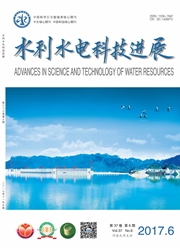

 中文摘要:
中文摘要:
针对在许多河道水动力及水环境模拟计算过程中仅有一定间距下的断面地形数据的实际情形,以黄浦江为例,分别采用三角网格法、反距离权重法和克里金法3种方法对强弯段、干支流交汇处及复式分汉河道的水下地形进行插值,以对比分析3种方法的适应性。结果表明,对于强弯段、干支流交汇处及复式分汉河道等地形起伏变化较大区域,三角网格法会造成插值结果不稳定,误差及波动大,未能反映部分地形起伏实际情况,反距离权重法可能出现“牛眼"现象,克里金法表现出较好的适应性:在减少测量断面时,克里金法的插值结果误差最小,强健性较好;将3种插值方法获得的黄浦江全河段插值地形用于整体潮位计算,克里金法计算精度最高。
 英文摘要:
英文摘要:
According to the actual situation in which the cross-sectional topographic data are discontinuous for hydrodynamic and aquatic environmental simulations, topographic interpolations for strongly curved reaches, river confluence, and braided rivers were conducted with the triangular mesh method, inverse distance weighting method, and Kriging method using the Huangpu River as an example. The reliability of these three interpolation methods was analyzed and compared. The results show that, for strongly curved reaches, river confluence, and braided rivers where topography varies significantly, the interpolation results of the triangular mesh method are unstable, with high errors and significant fluctuations, indicating that this method failed to reflect the actual topographic situation. The “buphthalmos” phenomenon may appear when the inverse distance weighting method is used. Compared with other methods, the Kriging method shows higher reliability. When fewer cross-sectional data are used, the results of the Kriging method show lower error and higher robustness than the other two methods. Based on the interpolation results of the topography of the Huangpu River with the above-mentioned three interpolation methods, a mathematical model was used to compare the tidal level processes, and the results show that the computational precision of the Kriging method is the highest.
 同期刊论文项目
同期刊论文项目
 同项目期刊论文
同项目期刊论文
 The effect of vegetation on sediment resuspension and phosphorus release under hydrodynamic disturba
The effect of vegetation on sediment resuspension and phosphorus release under hydrodynamic disturba Zero-valent nanophase iron and nitrogen co-modified titania nanotube arrays: Synthesis, characteriza
Zero-valent nanophase iron and nitrogen co-modified titania nanotube arrays: Synthesis, characteriza Self-assembly of different graphere-modified morphologies of Tio2: nanoparticle, nanorod and nanowir
Self-assembly of different graphere-modified morphologies of Tio2: nanoparticle, nanorod and nanowir Pollutant mixing and transport process via diverse transverse release positions in a multi-anabranch
Pollutant mixing and transport process via diverse transverse release positions in a multi-anabranch Flow Resistance and Velocity Structure in Shallow Lakes with Flexible Vegetation under Surface Shear
Flow Resistance and Velocity Structure in Shallow Lakes with Flexible Vegetation under Surface Shear Copper nanoparticles sensitized TiO2 nanotube arrays electrode with enhanced photoelectrocatalytic a
Copper nanoparticles sensitized TiO2 nanotube arrays electrode with enhanced photoelectrocatalytic a Multi-parameteridentification of a two-dimensional water-quality model based on theNelder-Mead Simpl
Multi-parameteridentification of a two-dimensional water-quality model based on theNelder-Mead Simpl β-Cyclodextrin inclusion complex as the immobilization matrix for laccase in the fabrication of a bi
β-Cyclodextrin inclusion complex as the immobilization matrix for laccase in the fabrication of a bi Heterogeneous Fenton degradation of bisphenol A catalyzed by efficient adsorptive Fe3O4/GO nanocompo
Heterogeneous Fenton degradation of bisphenol A catalyzed by efficient adsorptive Fe3O4/GO nanocompo 期刊信息
期刊信息
